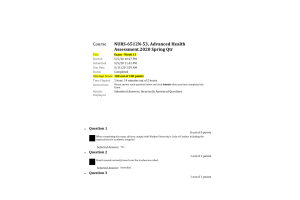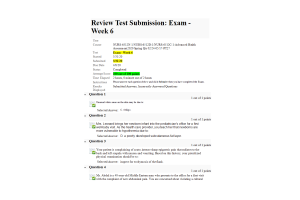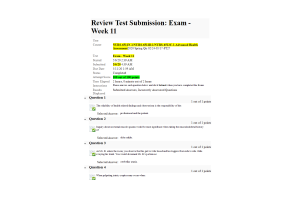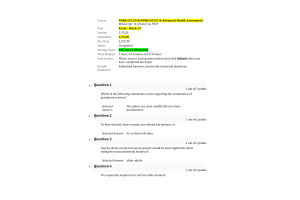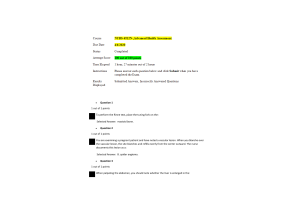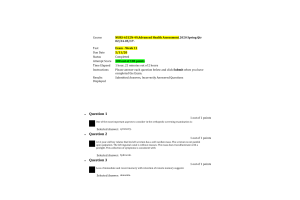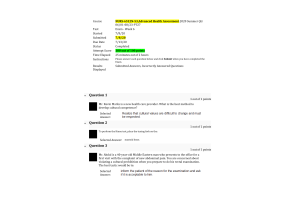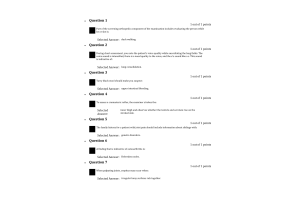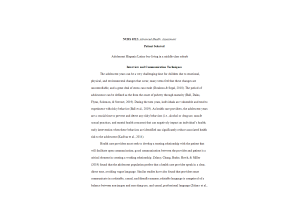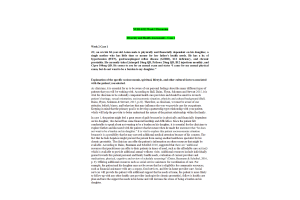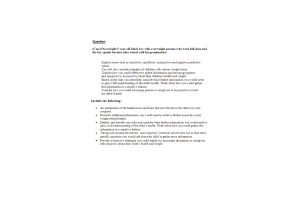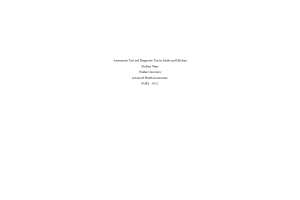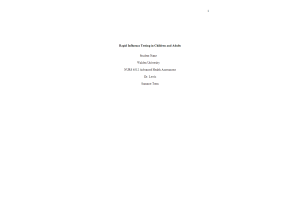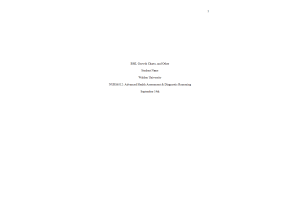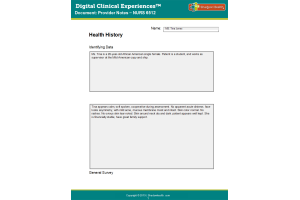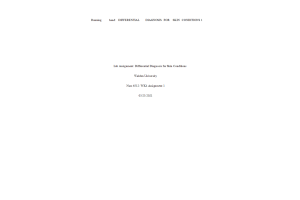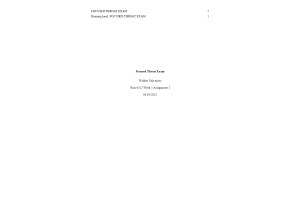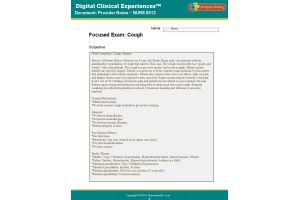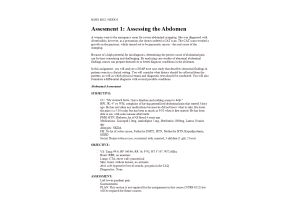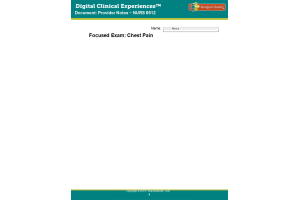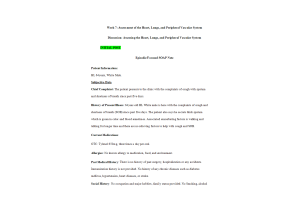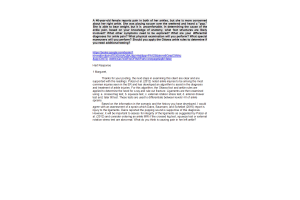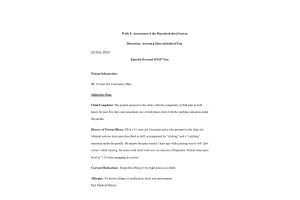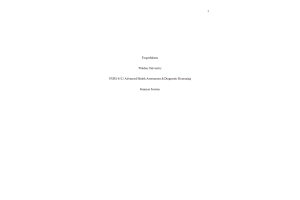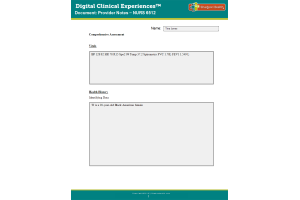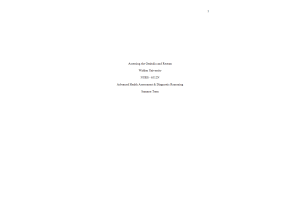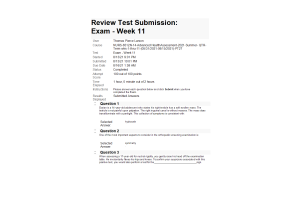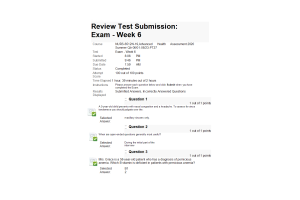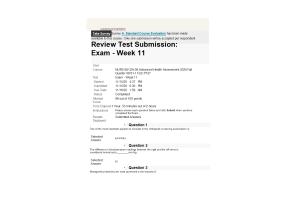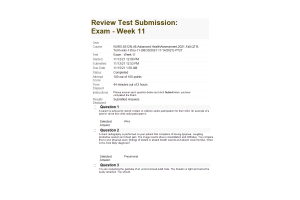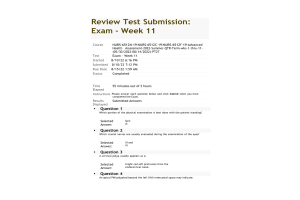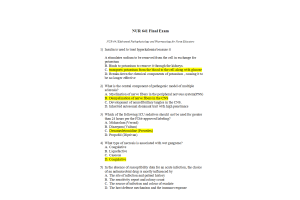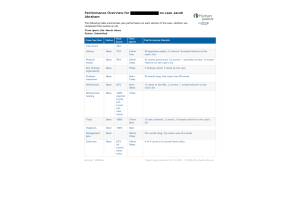NURS 6512N-49, Week 6 Midterm Exam; 100 out of 100 Points
- $49.00
NURS 6512 Advanced Health Assessment and Diagnostic Reasoning
- Question: Which of the following formats would be used for visits that address problems not yet identified in the problem-oriented medical record (POMR)?
- Question: Percussing at the right midclavicular line, below the umbilicus, and continuing upward is the correct technique for locating the:
- Question: Mr. Sanchez is a 45-year-old gentleman who has presented to the office for a physical examination to establish a new primary care health care provider. Which of the following describes a physical, not a cultural, differentiator?
- Question: In counseling a client regarding nutrition education, you explain that linoleic acid, a major fatty acid, is thought to be essential for:
- Question: To approximate vocal frequencies, which tuning fork should be used to assess hearing?
- Question: When taking a history, you should:
- Question: Unusual white areas on the skin may be due to:
- Question: Ms. Jones is a 31-year-old female patient who presents for a routine physical examination. Which examination technique will be used first?
- Question: Mr. Mills is a 55-year-old patient who presents to the office for an initial visit for health promotion. A survey of mobility and activities of daily living (ADLs) is part of a(an):
- Question: As you explain your patient's condition to her husband, you notice that he is leaning toward you and pointedly blinking his eyes. Knowing that he is from England, your most appropriate response to this behavior is to:
- Question: Brittle nails are typical findings in:
- Question: Mr. Black is a 44-year-old patient who presents to the clinic with complaints of neck pain that he thinks is from his job involving computer data entry. As the examiner, you are checking the range of motion in his neck and note the greatest degree of cervical mobility is at:
- Question: A blood pressure cuff bladder should be long enough to:
- Question: Inspection of the abdomen should begin with the patient supine and the examiner:
- Question: The review of systems is a component of the:
- Question: When assessing abdominal pain in a college-age woman, one must include:
- Question: When hearing is evaluated, which cranial nerve is being tested?
- Question: Which of the following is the most accurate reflection of an individual's food intake?
- Question: Differential diagnoses belong in the:
- Question: Tangential lighting is best used for inspecting skin:
- Question: Mrs. Berger is a 39-year-old woman who presents with a complaint of epigastric abdominal pain. You have completed the inspection of the abdomen. What is your next step in the assessment process?
- Question: Mr. Jones is a 45-year-old patient who presents for a physical examination. On examination, you note costochondral beading, enlarged skull, and bowed legs and diagnose him with rickets. A deficiency of which fat-soluble micronutrient can result in rickets?
- Question: When recording physical findings, which data are recorded first for all systems?
- Question: You are palpating a patient's thyroid and find that its broadest dimension measures 4 cm. The right lobe is 25% larger than the left. These data would indicate:
- Question: Mr. L. presents to the clinic with severe groin pain and a history of kidney stones. Mr. L.'s son tells you that, for religious reasons, his father wishes to keep any stone that is passed into the urine filter that he has been using. What is your most appropriate response?
- Question: What finding is unique to the documentation of a physical examination of an infant?
- Question: Which of the following is an expected change in the assessment of the thyroid during pregnancy?
- Question: When palpating the abdomen, you should note whether the liver is enlarged in the:
- Question: During an interview, you have the impression that a patient may be considering suicide. Which action is essential?
- Question: Subjective and symptomatic data are:
- Question: During an interview, tears appear in the patient's eyes and his voice becomes shaky. Initially, you should:
- Question: Expected normal percussion tones include:
- Question: When communicating with older children and teenagers, you should be sensitive to their:
- Question: Mrs. Britton is a 34-year-old patient who presents to the office with complaints of skin rashes. You have noted a 4' 3-cm, rough, elevated area of psoriasis. This is an example of a:
- Question: A brief statement of the reason the patient is seeking health care is called the:
- Question: Mrs. Britton brings her 16-year-old son in with a complaint that he is not developing correctly into adolescence. Which structures disproportionately enlarge in the male during adolescence?
- Question: Mrs. Hartzell is a 34-year-old patient who has presented for nutritional counseling because she is a vegetarian. Deficiency of which of the following is a concern in the vegetarian diet?
- Question: Knowledge of the culture or cultures represented by the patient should be used to:
- Question: Ms. Davis is a 27-year-old patient with a BMI of 33. Based on her BMI, your diagnosis would be:
- Question: A college student comes to the student health center complaining of difficulty in concentrating during class and while studying. The diet that would contribute to this problem is one that consumes mostly:
- Question: A 51-year-old woman calls with complaints of weight loss and constipation. She reports enlarged hemorrhoids and rectal bleeding. You advise her to:
- Question: Mr. Franklin is speaking with you, the health care provider, about his respiratory problem. Mr. Franklin says, "I've had this cough for 3 days, and it's getting worse." You reply, "Tell me more about your cough." Mr. Franklin states, "I wish I could tell you more. That's why I'm here. You tell me what's wrong!" Which caregiver response would be most appropriate for enhancing communication?
- Question: Mrs. G. reports an increase in her alcohol intake over the past 5 years. To screen her for problem drinking, you would use the:
- Question: Ms. Otten is a 45-year-old patient who presents with a complaint of weight gain. Which medication is frequently associated with weight gain?
- Question: A tool used to screen adolescents for alcoholism is the:
- Question: Underestimation of blood pressure will occur if the blood pressure cuff's width covers:
- Question: You are examining a pregnant patient and have noted a vascular lesion. When you blanche over the vascular lesion, the site blanches and refills evenly from the center outward. The nurse documents this lesion as a:
- Question: Coarse, dry, and brittle hair is associated with which metabolic disorder?
- Question: Which technique is most likely to result in the patient's understanding of questions?
- Question: The examiner's evaluation of a patient's mental status belongs in the:
- Question: Recommended carbohydrate content of total dietary intake (% total calories) is ____%.
- Question: Sweat glands, hair, and nails are all formed from:
- Question: Your patient is complaining of acute, intense sharp epigastric pain that radiates to the back and left scapula with nausea and vomiting. Based on this history, your prioritized physical examination should be to:
- Question: When examining the skull of a 4-month-old baby, you should normally find:
- Question: After thorough inspection of the abdomen, the next assessment step is:
- Question: Mr. Walters, a 32-year-old patient, tells you that his ears are "stopped up." An objective assessment of this complaint is achieved by using the:
- Question: Expected hair distribution changes in older adults include:
- Question: The infant should be placed in which position to have his or her height or length measured?
- Question: Mr. D. complains of a headache. During the history, he mentions his use of alcohol and illicit drugs. This information would most likely belong in the:
- Question: Pigmented, raised, warty lesions over the face and trunk should be assessed by an experienced practitioner who can distinguish:
- Question: A 22-year-old female nurse is interviewing an 86-year-old male patient. The patient avoids eye contact and answers questions only by saying, "Yeah," "No," or "I guess so." Which of the following is appropriate for the interviewer to say or ask?
- Question: A guideline for history taking is for caregivers to:
- Question: Auscultation should be carried out last, except when examining the:
- Question: Mr. Akins is a 78-year-old patient who presents to the clinic with complaints of hearing loss. Which of the following are changes in hearing that occur in the elderly? Select all that apply.
- Question: Peritonitis produces bowel sounds that are:
- Question: Nuchal rigidity is most commonly associated with:
- Question: Mrs. Leonard brings her newborn infant into the pediatrician's office for a first well-baby visit. As the health care provider, you teach her that newborns are more vulnerable to hypothermia due to:
- Question: Mr. and Mrs. Johnson have presented to the office with their infant son with complaints of ear drainage. When examining an infant's middle ear, the nurse should use one hand to stabilize the otoscope against the head while using the other hand to:
- Question: Bulging of an amber tympanic membrane without mobility is most often associated with:
- Question: Peritonitis produces bowel sounds that are:
- Question: Which of the following is an "ABCD" characteristic of malignant melanoma?
- Question: During physical examination of a 30-year-old Chinese man, you notice slight asymmetry of his face. The cranial nerve examination is normal. Your best action is to:
- Question: When assessing abdominal pain in a college-age woman, one must include:
- Question: You are planning to palpate the abdomen of your patient. Which part of the examiner's hand is best for palpating vibration?
- Question: Mr. Johnson presents with a freely movable cystic mass in the midline of the high neck region at the base of the tongue. This is most likely a:
- Question: To correctly document absent bowel sounds, one must listen continuously for:
- Question: Macronutrients are so named because they:
- Question: George Michaels, a 22-year-old patient, tells the nurse that he is here today to "check his allergies." He has been having "green nasal discharge" for the last 72 hours. How would the nurse document his reason for seeking care?
- Question: Tympanic thermometers measure body temperature when a probe is placed:
- Question: White, rounded, or oval ulcerations surrounded by a red halo and found on the oral mucosa are:
- Question: Mrs. Webb is a 38-year-old patient who has been changing her lifestyle to eat in a healthy way and lose weight. During your health promotion education regarding her nutritional status, you explain the function of dietary protein as:
- Question: Mrs. Raymonds is a 24-year-old patient who has presented for a routine concern over her current weight. In your patient teaching with her, you explain the importance of macronutrients. Which of the following is a macronutrient?
- Question: To perform the Rinne test, place the tuning fork on the:
- Question: A detailed description of the symptoms related to the chief complaint is presented in the:
- Question: A 17-year-old girl presents to the clinic for a sports physical. Physical examination findings reveal bradycardia, multiple erosions of tooth enamel, and scars on her knuckles. She appears healthy otherwise. You should ask her if she:
- Question: Spasmodic muscular contractions of the head, face, or neck are called:
- Question: Before performing an abdominal examination, the examiner should:
- Question: Mr. Donalds is a 45-year-old roofer. Your inspection to determine color variations of the skin is best conducted:
- Question: You are using an ophthalmoscope to examine a patient's inner eye. You rotate the lens selector clockwise, then counterclockwise to compensate for:
- Question: Which type of speculum should be used to examine a patient's tympanic membrane?
- Question: During percussion, a dull tone is expected to be heard over:
- Question: Which technique is most likely to result in the patient's understanding of questions?
- Question: Which is the best way to position a patient's neck for palpation of the thyroid?
- Question: Which cranial nerves innervate the face?
- Question: Nasal symptoms that imply an allergic response include:
- Question: In examining the neck of a 34-year-old female patient, you note that the uppermost ridge of the tracheal cartilage is at the:
- Question: The term denoting the caregiver's need to do no harm to the patient is:
- Question: Ms. G. is being seen for her routine physical examination. She is a college graduate and president of a research firm. Although her exact salary is unknown, she has adequate health insurance. Most of the above information is part of Ms. G.'s _____ history.
- Question: Under normal circumstances, how much water is lost daily by the body?
- Question: When are open-ended questions generally most useful?

